Knowledge Center
- Downloads
- Technical Newsletter
- Recommended Guidelines and References
- Specifications
- Technical Papers
- Tools and Calculators
- Training
- Articles, Tips and Requirements
- An Integrated Approach to Manage Vibration Risks
- Design Requirements for Reciprocating Compressors
- Evaluating Compressor Operating Risks
- Five simple methods to check reciprocating compressor performance
- Important Differences in Pulsation Software
- Liquid Pumping Systems (Including Liquid Pipelines)
- Noise Regulations Around the World
- Noise Risks in the Gas Industry
- Performance Monitoring Examples
- Pipe Support Stiffness, GMRC Project
- Piping Vibration Design Considerations
- Piping Vibration Examples
- Structural Vibration and Ways to Avoid It
- Tips for a Successful Project (Vibration Control)
- Transient Conditions on Small-Bore Piping
- Vendor Requirements for Piping Vibration & Integrity Assessment
- Vibration-induced fatigue (whitepaper)
- Vibration Issues Affecting Gas Compressor Facilities
- Ask the expert
Evaluating Compressor Operating Risks
Reciprocating gas compressors operate across a range of suction pressures, discharge pressures, and flow rates. This operating flexibility is one of the benefits of reciprocating machinery.
Achieving this operating flexibility requires vibration-free operation over the entire operating envelope. Too often this is not the case; it is common to find a compressor system that has been designed to work well at a few conditions, but not at others. As outlined below, these problems are easily avoided.
Contents [ hide ]
1 Compressor Selection Using a Few Design Points
Engineers often select a compressor based on a few points. The goal is to ensure the compressor will meet the required capacity and pressures. Figure 1 illustrates the five points used to size this 4500 HP compressor. The Figure shows the 2D and 3D view of the compressor’s operating map, illustrates the range of suction and discharge pressures, and the required loads steps (3D view, vertical axis).
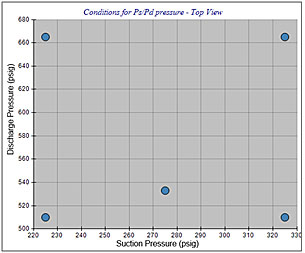 |
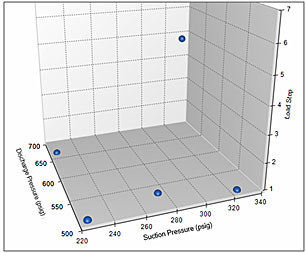 |
| Figure 1: Operating Map (suction vs. discharge pressure vs. load step). Left, 2D, Right, 3D View | |
2 Vibration Varies Across the Operating Map
Traditionally, these few design points are used to analyze pulsation and vibration risks and provide a vibration solution including pulsation control. Figure 2a shows these five points. The green circle indicates that pulsation forces have been reduced below the API 618 guideline.
The problem is that at other operating conditions, vibration problems will occur. For this project, Beta Machinery Analysis (Wood) evaluated 100 conditions across the operating map. Figure 2b, illustrates the pulsation forces – and it is now apparent that in many conditions, the pulsation forces are marginally above guideline (yellow), or significantly above guideline (red). By evaluating the overall map, Wood is able to design a more reliable vibration solution for the customer.
The key point is that the vibration risk varies widely across the operating map and should be evaluated during the pulsation/vibration study.
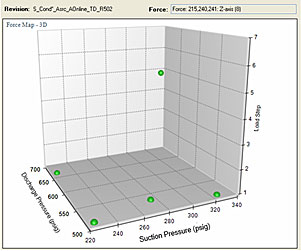 |
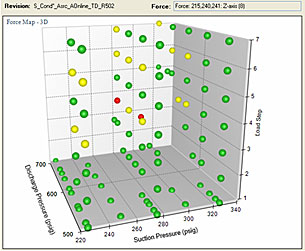 |
| Figure 2a: Pulsation Analysis - 5 Points | Figure 2b: Pulsation Force Map over the Entire Operating Range |
3 Wood DataMiner™ Toolkit - A New Approach to Evaluating Operational Risks
Evaluating the complex vibration information can be a daunting task. For a typical report, there can be over 300 pages of plots to document the pulsations and/or other operational data across the piping system (nodes), over the frequency range, compressor speed, and operating parameters.
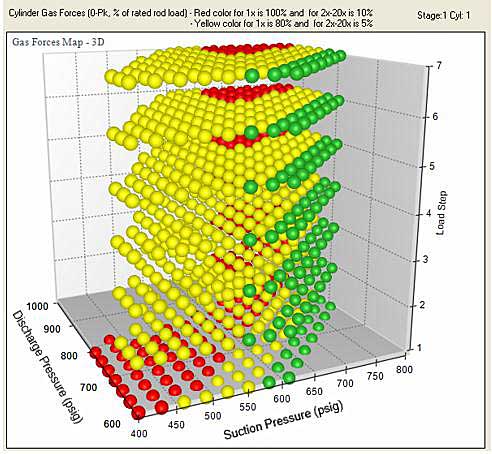 Many consultants will only evaluate a few conditions to avoid the complexities associated with analysis
Many consultants will only evaluate a few conditions to avoid the complexities associated with analysis
Wood has developed a proprietary modelling toolkit called DataMiner. This allows Wood to easily (and cost effectively) evaluate the overall operating map – from 20 to 1000 conditions. This evaluation is now popular with complex compressor installations including gas storage, pipeline, and other situations which require a wider range of operation (see examples).
DataMiner can produce a wide variety of 2D and 3D plots illustrating how these variables change over the operating map: Some examples of operating parameters that can be fully analyzed.
- Pressure Pulsations
- Pulsation Forces vs. Guideline
- Cylinder Gas Forces and other Forces Acting on the Compressor
- Performance (capacity, load, etc).
- Pressure Drop
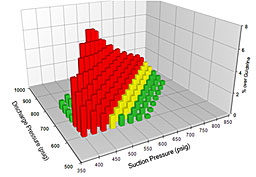 |
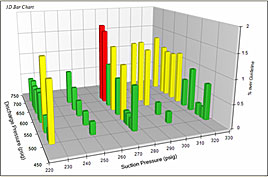 |
Contact Wood for your next project at info.vdn@woodplc.com
Related Pages
Design Requirements for Reciprocating Compressors • Specifications •
Free webinar
Learn how to select and design vibration control solutions that work – using real-world data and case studies. Register now



